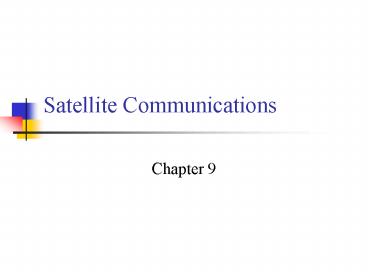Satellite Communications - PowerPoint PPT Presentation
1 / 24
Title:
Satellite Communications
Description:
Classification of Satellite Orbits. Circular or elliptical orbit ... Disadvantages of the GEO orbit. Weak signal after traveling over 35,000 km ... – PowerPoint PPT presentation
Number of Views:29
Avg rating:3.0/5.0
Title: Satellite Communications
1
Satellite Communications
- Chapter 9
2
Satellite-Related Terms
- Earth Stations antenna systems on or near earth
- Uplink transmission from an earth station to a
satellite - Downlink transmission from a satellite to an
earth station - Transponder electronics in the satellite that
convert uplink signals to downlink signals
3
Ways to CategorizeCommunications Satellites
- Coverage area
- Global, regional, national
- Service type
- Fixed service satellite (FSS)?
- Broadcast service satellite (BSS)?
- Mobile service satellite (MSS)?
- General usage
- Commercial, military, amateur, experimental
4
Classification of Satellite Orbits
- Circular or elliptical orbit
- Circular with center at earths center
- Elliptical with one foci at earths center
- Orbit around earth in different planes
- Equatorial orbit above earths equator
- Polar orbit passes over both poles
- Other orbits referred to as inclined orbits
- Altitude of satellites
- Geostationary orbit (GEO)?
- Medium earth orbit (MEO)?
- Low earth orbit (LEO)?
5
Geometry Terms
- Elevation angle - the angle from the horizontal
to the point on the center of the main beam of
the antenna when the antenna is pointed directly
at the satellite - Minimum elevation angle
- Coverage angle - the measure of the portion of
the earth's surface visible to the satellite
6
Minimum Elevation Angle
- Reasons affecting minimum elevation angle of
earth stations antenna (gt0o)? - Buildings, trees, and other terrestrial objects
block the line of sight - Atmospheric attenuation is greater at low
elevation angles - Electrical noise generated by the earth's heat
near its surface adversely affects reception
7
GEO Orbit
- Advantages of the the GEO orbit
- No problem with frequency changes
- Tracking of the satellite is simplified
- High coverage area
- Disadvantages of the GEO orbit
- Weak signal after traveling over 35,000 km
- Polar regions are poorly served
- Signal sending delay is substantial
8
LEO Satellite Characteristics
- Circular/slightly elliptical orbit under 2000 km
- Orbit period ranges from 1.5 to 2 hours
- Diameter of coverage is about 8000 km
- Round-trip signal propagation delay less than 20
ms - Maximum satellite visible time up to 20 min
- System must cope with large Doppler shifts
- Atmospheric drag results in orbital deterioration
9
LEO Categories
- Little LEOs
- Frequencies below 1 GHz
- 5MHz of bandwidth
- Data rates up to 10 kbps
- Aimed at paging, tracking, and low-rate messaging
- Big LEOs
- Frequencies above 1 GHz
- Support data rates up to a few megabits per sec
- Offer same services as little LEOs in addition to
voice and positioning services
10
MEO Satellite Characteristics
- Circular orbit at an altitude in the range of
5000 to 12,000 km - Orbit period of 6 hours
- Diameter of coverage is 10,000 to 15,000 km
- Round trip signal propagation delay less than 50
ms - Maximum satellite visible time is a few hours
11
Frequency Bands Available for Satellite
Communications
12
Satellite Link Performance Factors
- Distance between earth station antenna and
satellite antenna - For downlink, terrestrial distance between earth
station antenna and aim point of satellite - Displayed as a satellite footprint (Figure 9.6)?
- Atmospheric attenuation
- Affected by oxygen, water, angle of elevation,
and higher frequencies
13
Satellite Footprint
14
Satellite Network Configurations
15
Capacity Allocation Strategies
- Frequency division multiple access (FDMA)?
- Time division multiple access (TDMA)?
- Code division multiple access (CDMA)?
16
Frequency-Division Multiplexing
- Alternative uses of channels in point-to-point
configuration - 1200 voice-frequency (VF) voice channels
- One 50-Mbps data stream
- 16 channels of 1.544 Mbps each
- 400 channels of 64 kbps each
- 600 channels of 40 kbps each
- One analog video signal
- Six to nine digital video signals
17
Frequency-Division Multiple Access
- Factors which limit the number of subchannels
provided within a satellite channel via FDMA - Thermal noise
- Intermodulation noise
- Crosstalk
18
Forms of FDMA
- Fixed-assignment multiple access (FAMA)?
- The assignment of capacity is distributed in a
fixed manner among multiple stations - Demand may fluctuate
- Results in the significant underuse of capacity
- Demand-assignment multiple access (DAMA)?
- Capacity assignment is changed as needed to
respond optimally to demand changes among the
multiple stations
19
FAMA-FDMA
- FAMA logical links between stations are
preassigned - FAMA multiple stations access the satellite by
using different frequency bands - Uses considerable bandwidth
20
DAMA-FDMA
- Single channel per carrier (SCPC) bandwidth
divided into individual VF channels - Attractive for remote areas with few user
stations near each site - Suffers from inefficiency of fixed assignment
- DAMA set of subchannels in a channel is treated
as a pool of available links - For full-duplex between two earth stations, a
pair of subchannels is dynamically assigned on
demand - Demand assignment performed in a distributed
fashion by earth station using CSC
21
Reasons for Increasing Use of TDM Techniques
- Cost of digital components continues to drop
- Advantages of digital components
- Use of error correction
- Increased efficiency of TDM
- Lack of intermodulation noise
22
FAMA-TDMA Operation
- Transmission in the form of repetitive sequence
of frames - Each frame is divided into a number of time slots
- Each slot is dedicated to a particular
transmitter - Earth stations take turns using uplink channel
- Sends data in assigned time slot
- Satellite repeats incoming transmissions
- Broadcast to all stations
- Stations must know which slot to use for
transmission and which to use for reception
23
FAMA-TDMA Uplink
24
FAMA-TDMA Downlink































